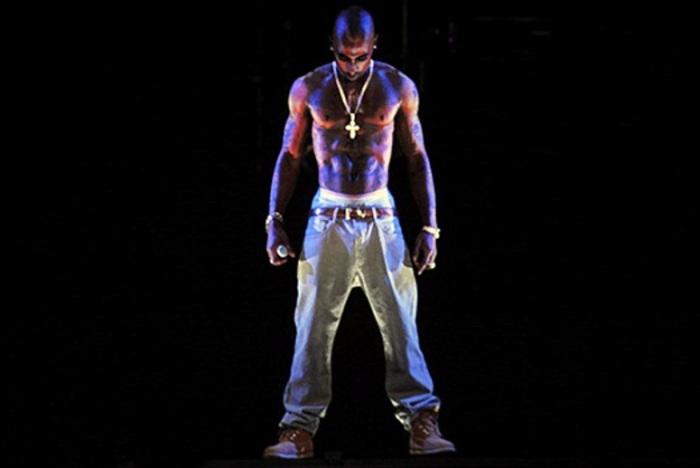
By now I’m sure many of you have seen or heard that this year’s Coachella featured a hologram performance of Tupac. Not by Tupac, of course, but of Tupac. With Snoop. It was weird. Hologram performances aren’t technically new; there’s a CGI hologram popstar in Japan named Hatsune Miku, which started out as a way to promote vocal software and grew into a fully synthesized recording “artist” which then transitioned to doing live shows as a hologram in 2009. I figured this tech would come to North America eventually, but I imagined something along the lines of a contrived creation akin to the Gorillaz or maybe Brittney Spears. But no, instead it came in the form of the revived corpse of one of the most beloved rappers who died at the peak of his popularity.
It instantly made me think of this video on the Death and Return of Superman by Max Landis which made the rounds on the net a few months ago (it’s funny, you should watch it, or skip to 15:03 for the relevant part). The primary theory is thus: the Death and Return of Superman story arc that DC Comics rolled out in 1992 did two things. 1. It made a shit-ton of cash. 2. It opened the doors to bring back a whole host of dead or forgotten superheroes, either through acrobatic narrative wrangling like time travel or cloning or magic or through reboots like alternate dimensions or timelines or what-if scenarios. This had happened before Superman, but the profile and $$$ involved, according to Landis, was a game changer. In short, it broke death in comics.
Well, Hologram Tupac has broken death in music.
It doesn’t seem like the move has pissed many people off. Dr. Dre got the blessing of Tupac’s Mom to do this and there’s already chatter about a Zombie Tupac tour. Sure, some people no doubt find this weird and offensive, but those people are apparently in the minority. The rest are just glad to be able to have an experience akin to the original. Consider the way some performances are mythologized, like James Brown at the Apollo in 1962 or Sam Cooke at Harlem Square. They’re spoken of which such high praise they sound transcendental. Of course fans unable to have those experiences would pay 40 shekels to see the next best thing.
How many people do you think would pay to see Michael Jackson again? Or the original Beatles lineup? Not to mention Queen, Frank Sinatra, or hell Pavarotti. Dr. Dre has already said it’d be cool to virtually dig up Jimi Hendrix and Marvin Gaye. Death has never been much of an ethical obstacle for the entertainment industry. Sony jacked up the price of Whitney Houston’s catalogue as soon as they found out she died, Natalie Cole recorded a “virtual duet” with her dead father Nat King Cole, Kurt Cobain’s private journal was a bestseller, and a host of dead celebrities have been shopped into film and vacuum commercials.
The possibilities are endless, especially considering Hologram Tupac didn’t even require the use of existing footage. The process for making the hologram sounds a bit vague, as the special effects company behind it insists “This is not found footage. This is not archival footage. This is an illusion.” The company that staged the illusion (different from the company that created the character, movements, etc.) said “You can take their likenesses and voice and… take people that haven’t done concerts before or perform music they haven’t sung and digitally re-create it.” We can have new music by Ritchie Valens, old Bob Dylan playing alongside young Bob Dylan, or Biggie and Tupac: Burying the Hatchet Tour.
Plus, considering the costs of large stage shows, a hologram could be downright cost effective. As Robert Michael of CNNGo put it, “forget the tantrums, entourage, and ridiculous riders.” A hologram never makes mistakes (tech glitches aside), you don’t have to pay for a hotel or food, they don’t get old, they don’t get injured, they don’t get tired, they don’t take breaks, and they don’t ever say “no.” And there are artists who have built up such a discography that fan interest is resilient (Elvis, Burt Bacharach, people even still pay to see Tiffany at casinos and local fairs). Just think about how many people pay to see cover bands. Plus one performance could probably tour for a year or more before having to be updated… I mean, upgraded.
Oh, and dear new musicians, we currently live in a time where you’re actively competing against all of recorded music history. There is as much access, if not more, to the The Beatles music today as there was in 1960. (The Beatles had the highest selling vinyl record, Abbey Road, in both 2010 and 2011.) If person A only has 40 bones to spend on music, they have way more options today than they’ve ever had before and therefore a much more difficult choice, and that will only accumulate as time goes on. Well now your Friday night gig is also up against the digital marionette of Chuck Berry and the Opera House won’t book you because the ghost of Serge Gainsbourg has been doing pretty well these days.
Of course much of this is pie-in-sky, this isn’t some slippery slope to the end times of new music. It’s also not like we’ll ever get to see The Unicorns or the Sea Snakes again. But death is no longer the nail in the coffin, so to speak. We don’t need new artists to dig up old sounds, we can just dig up old artists.
R.I.P. Royalties in Perpetuity.
P.S. There’s a million theoretical tendrils to explore with this. As referenced in that Superman video up there, there’s a big difference between these two instances. Superman doesn’t exist. You can make up whatever you want about him and make him do whatever you want because Superman is made up. But Tupac isn’t made up. Nor are any of the artists I’ve mentioned. What liberty will then be taken with their identity? If an artist has existed as a hologram longer than they existed as a living person, what remnant of their former selves will remain in their work? Like a photocopy of a photocopy of a photocopy, the end product can and will likely be something very different from the person. I think there was a Futurama joke that I don’t really remember but I’ll make up to prove my point: Person in the future talks to person from the past about a cultural icon: “It must’ve been amazing to see them in person, since they were 50 feet tall and could shoot lazers out of their eyes.” “They could? Man, I really should’ve gone to that show.”
Apologies to Futurama.
P.P.S. Food for thought: Hologram Martin Luther King. Hologram Osama Bin Laden. Hologram dummy cops. Hologram of your dead grandfather telling war stories at Christmas. etc. etc. etc.
– by Ryan McLaren

